Hardware
Description of lab equipment used for research within the group.
NASA Valkyrie Robot
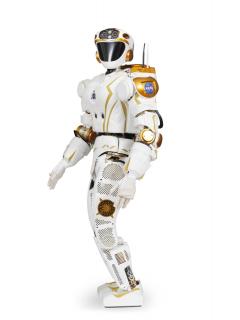
The NASA Valkyrie is one of the most advanced humanoid robots in the world. The robot, based at the University of Edinburgh since Spring 2016, is developed and worked on in collaboration with NASA-JSC. Weighing 136 kg and standing 1.8m tall, Valkyrie is used for research in enabling breakthroughs in humanoid control, motion planning, perception, and cross cutting research in human rehabilitation.
Technical Specification:
-
44 DoF
-
12-DoF legs: 6-DoF for each leg
-
14-DoF arms: 7-DoF for each arm
-
12-DoF hands: 6-DoF for each hand with underactuated tendon driven fingers
-
3-DoF neck
-
3-DoF waist
-
-
Weight: 136 kg
-
Height: 1.8m
Sensors: MultiSense SL, Anterior hazard cameras, LORD MicroStrain IMU, ATI Multi-Axis Force/Torque Sensors
Outreach Videos: [The Project] [Media Coverage] [Motion Planning]
PAL Talos
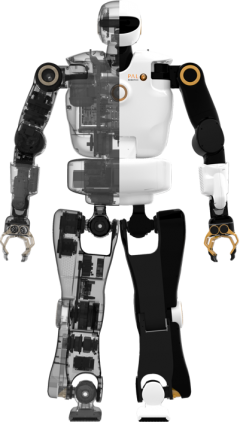
TALOS is an advanced humanoid designed to perform complex tasks in research and industrial settings. It uses torque control to move its limbs and can walk on uneven terrain, sense its environment, and operate power tools. The robot is fully electrically actuated, capable of lifting 6-kilogram payloads per arm, dynamic walking, including on uneven ground and stairs, and can complete tasks using power tools. The Talos robot is fully ROS enabled and supporting our research in motion control, planning, state estimation, and human-robot collaboration.
Technical Specification:
-
DoFs: 32 DoF
-
12-DoF legs: 6-DoF for each leg
-
14-DoF arms: 7-DoF for each arm
-
2-DoF hands: 1-DoF for each hand
-
2-DoF neck
-
2-DoF waist
-
-
Series Elastic Actuators
-
Height: 175 cm
-
Weight: 95 kg
Sensors: Torque sensors in all joints, Force/Torque Sensors in ankles and wrists, RGBD camera mounted in the head, and a high precision IMU with a fiber optic gyroscope.
Nextage Bi-manual Humanoids
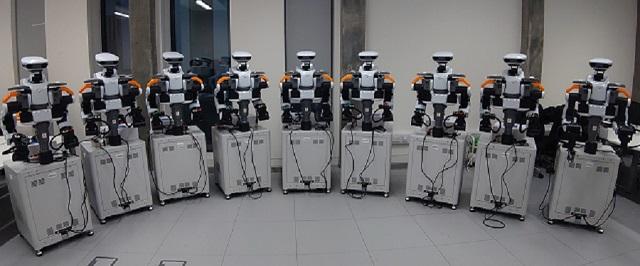
Edinburgh is host to 9 advanced NextageA bimanual humanoid robots, manufactured by Kawada Industries in Japan. Each platform weighs 80kg and features 15 degrees of freedom. Delivered in late 2019, the broad research topics being explored by our lab with these platforms include teleoperation, motion-planning, perception and vision. The NextageA robots are also used to deliver one-of-a-kind courses with focus on practical aspects of robotics and industry driven applications.
Technical Specification:
-
DoFs: 15 DoF
-
12-DoF arms: 6-DoF for each arm
-
2-DoF head
-
1-DoF waist
-
Fixed-base platform (wheeled)
-
-
Vision: 4 cameras
-
Head: 2 cameras in stereo pair
-
End effectors: 1 camera on each hand
-
-
Position or Velocity controlled
-
Payload: 1.5kg per arm (3kg in total)
-
Height: 174 cm
-
Weight: 80 kg
-
Mechanical compliance sensors, pneumatic cabling and gripper support, ROS-enabled
EVA
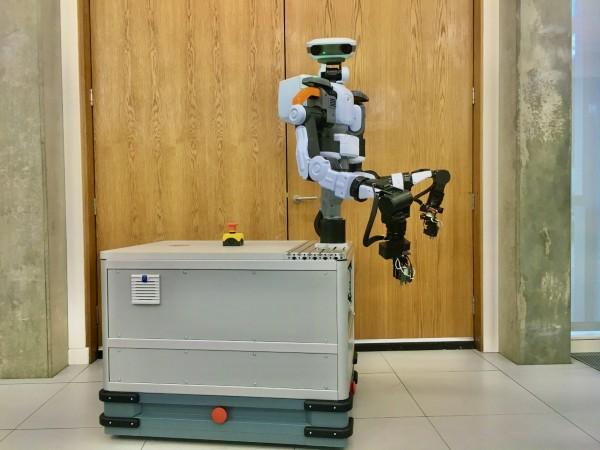
EVA, the University of Edinburgh’s newest hybrid robotic platform. EVA is an efficient and versatile robotic assistant. By using a mobile base for locomotion, we overcome the challenges of biped motion and achieve a safer and more robust platform. This one-of-a-kind humanoid robotic platform will be used by students and researchers at the University of Edinburgh, to conduct cutting edge research on machine learning algorithms for optimal control, planning and manipulation.
[Introducing EVA - new mobile robot for human-robot interaction]
ANYmal Bull with Kinova Jaco Manipulator Arm
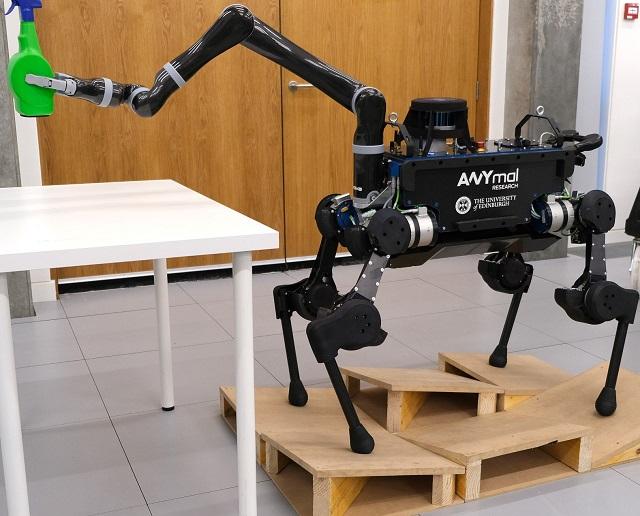
ANYmal Bull is a fully torque-controlled quadruped robot equipped with a Kinova Jaco robot arm. The robot has been part of our lab since Fall 2019, and is a key platform for legged loco-manipulation research. The arm mounted on the quadruped is used as a manipulator capable of interacting with its environment, but it can also be used as an extra limb in order to unlock nonconventional multi-contact transitions. The robot is equipped with several sensors for perception and state estimation.
Technical Specification:
-
No. actuated joints: 18
-
3-DoF leg (4x)
-
6-DoF arm
-
-
Perception sensors:
-
Total weight: ~40.7 kg
-
Quadruped: ~35.2 kg
-
Kinova Gen2 arm: ~5.0 kg
-
ANYmal Bedi
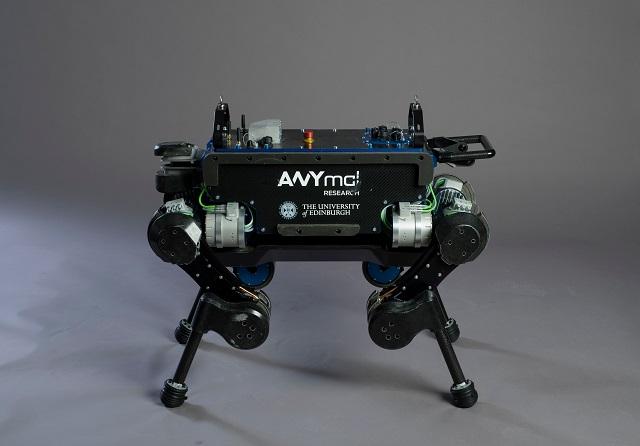
The ANYmal Bedi is our major platform for quadruped locomotion research. The robot arrived at our lab in 2017. The robot weighs 30 kg and has 12 joints with exceptionally large ranges of motion suitable for different types of locomotion. The vision of our lab is to develop capable motion planning and control algorithms to enable real-world deployment of the robot.
Technical Specification:
-
12 DOF: 3 for each leg
-
Series Elastic Actuators
-
Torque Controlled
-
Weight: 30kg
Ada500 Omnidirectional Mobile Manipulator
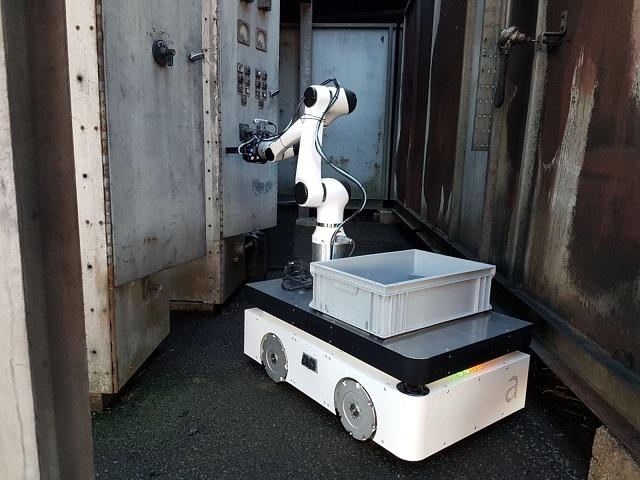
The Ada500 platform is designed for SLAM and mobile manipulation applications in industrial environments. The omni-directional motion of the robot allows for versatile navigation, and the 6 DoF robot arm allows it perform manipulation and inspection tasks. The robot was developed in our lab in 2018 and designed to support our research on multi-modal perception for state estimation and object tracking.
Technical Specification:
-
Omnidirectional mobile base
-
6 DoF manipulator arm
-
500kg payload
Sensors: LORD MicroStrain IMU, Intel RealSense RGBD camera
Husky with Bi-manual UR5 Arms
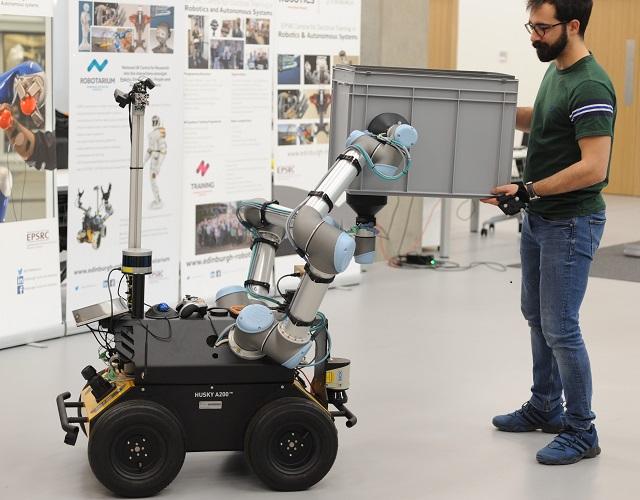
The bimanual Husky is used in our shared autonomy and remote operations research. The robot arrived at our lab in 2016 and is equipped with a number of sensors to perceive the environment, a mobile base that allows it to navigate both indoor and outdoor environments and two UR5 manipulators with a Robotiq 3-finger end-effector each used to manipulate its environment.
Technical Specification:
-
15 DOF: two 6-DoF Universal Robot UR5 + 3-DoF mobile base
-
End-effectors: two Robotiq 3-finger grippers with a Robotiq F/T sensor each
-
Position or Velocity controlled
-
One Asus Xtion
-
One PointGrey Bumblebee2 stereo camera mounted on a 2-DoF pan-tilt unit
-
One Sick LMS- 100 LIDAR
PR2
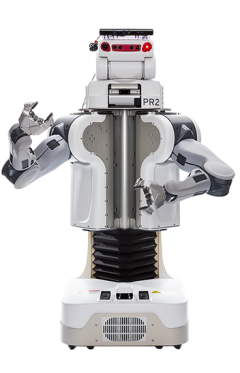
PR2 is a human-scale mobile manipulation platform built by Willow Garage. The robot has arrived in our lab in 2016. PR2 combines the mobility to navigate human environments and the dexterity to grasp and manipulate objects in those environments. The research on PR2 focuses on reinforcement learning and human-robot collaboration.
Technical Specification:
-
DoFs: 12 DoF
-
8-DoF arms: 4-DoF for each arm
-
2-DoF hands: 1-DoF for each hand
-
2-DoF neck : Head pan / tilt
-
-
Omnidirectional mobile base (Speed: 1m/s)
-
Perception Sensors:
-
Head: Microsoft Kinect and 5-megapixel camera
-
Torso: Hokuyo UTM-30LX (Lidar) and Microstrain 3DM-GX2 IMU
-
Wrist: Ethernet cameras, three-axis accelerometer, and fingertip pressure sensors
-
Base: Hokuyo UTM-30LX (Lidar)
-
-
Payload: 1.5kg per arm (3kg in total)
-
Height: 165 cm
-
Weight: 226.8 kg
Baxter
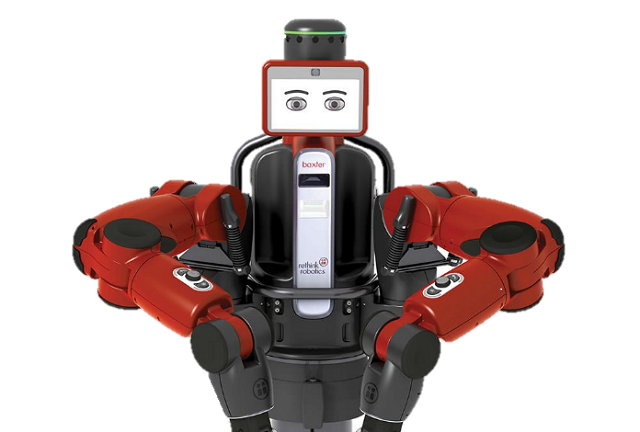
Baxter is a dual-arm robot with an animated face to work collaboratively with people. One of the unique characteristics of Baxter is its force sensing capability implemented using series elastic actuators (SEAs). The robot arrived in our lab in 2015 and the research on it focused on human-robot collaboration and assembly automation.
Technical Specification:
-
DoFs: 16 DoF
-
14-DoF arms: 7-DoF for each arm
-
2-DoF necks:
-
-
Perception Sensors: 5 cameras and 1 sonar
-
Head: 1 camera and 360-degree sonar
-
Torso: 2 cameras
-
Wrist: 1 camera in each forearm
-
-
Height: 94 cm (waist to head)
-
Weight: 75 kg (not including pedestal)
Bimanual Manipulation Platform: KUKA iiwa + Shadow Dexterous Hands
The bimanual KUKA iiwa is used for pick and place operations of large objects, and human-robot collaborative manipulation scenarios. The extensive payload of the iiwa arms (14kg each) enables manipulation of large objects, and is a key aspect toward assisting humans in moving objects that other robot platforms can’t handle. The anthropomorphic Shadow Dexterous Hands closely resemble the human hands, and are equipped with tactile sensors that provide detailed force, micro-vibration and temperature sensing. Both the sensing capabilities and the dexterity of the hands are crucial in our research on agile in-hand manipulation.
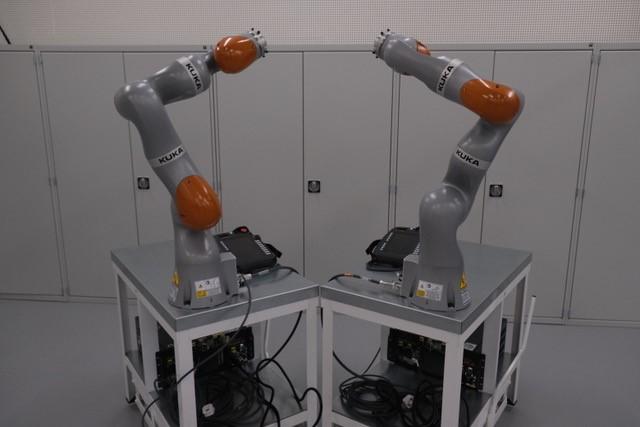
Arm Specs:
-
-
Two 7-DoF KUKA LBR iiwa each mounted on a separate base
-
Position or Velocity or Torque controlled
-
Payload: 14kg each
-
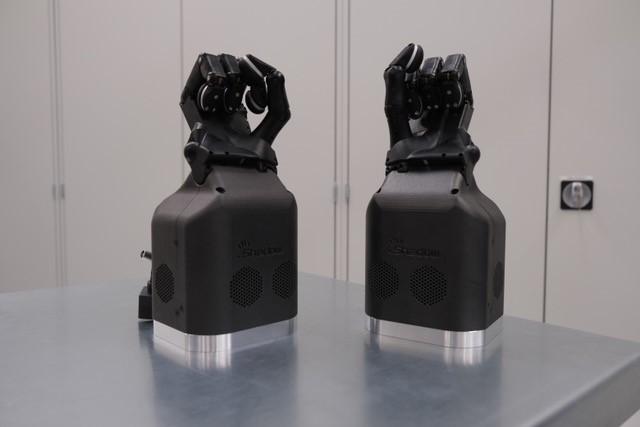
End-effector Specs:
-
-
Two Shadow Dexterous Hands 24-DoF each, with an ATI F/T sensor each
-
Two Shadow Dexterous Hands 24-DoF each, with an ATI F/T sensor each and BioTac Sensors
-
Position controlled
-
Payload: 5kg each
-
KUKA Light Weight Robot (LWR) arm + SCHUNK Dexterous Hand (SDH)
The SLMC group was one of the first recipients of the DLR LWR III arm designed for research and manufactured by KUKA, the predecessor of the current iiwa arm. Each joint contains both accurate
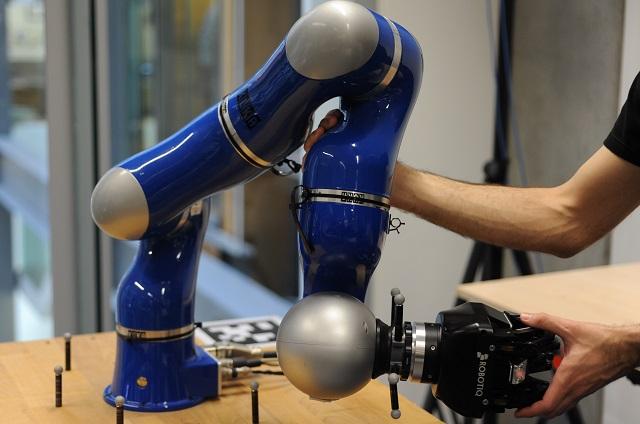
position and torque sensors which allow for highly dynamic motions. The arm is equipped with the Schunk Dexterous Hand (SDH), a fully actuated 3-finger grasping hand with a tactile sensor array system at the fingertips for pressure detection and surface recognition, which allows it to grasp objects with precise force control.
Specs: 7 DOF arm (KUKA): 15kg, Payload 7kg; 5 DOF hands (SCHUNK): 1.95kg
Upper Limb Prosthetics: Touch Bionics iLIMB (2013) and Azzura IH2 (2016)
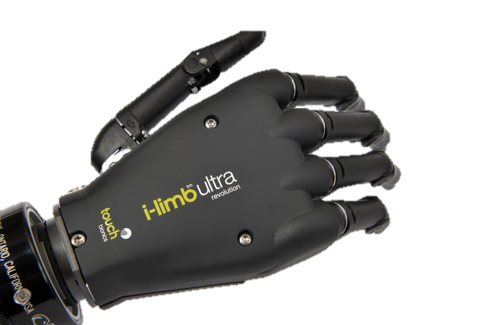
Our lab has three copies of the Touch Bionics Robolimb, which is a myoelectric, multi-articulating prosthetic hand that offers five individually powered digits and manually rotatable thumb. We also use iLIMB, an earlier version of the robolimb, and Össur i-Limb Quantum, its successor with an actuated thumb, in our research.
For individual digit control, we use the Azzura IH2 robotic hands with all functional components (5 motors, tactile sensors and control electronics) integrated in the palm and in the underactuated, self-adaptive fingers. It has the ability to perform multiple grasps and sense objects with simple communication interface (RS-232 over USB or Bluetooth) and standard prosthetic wrist attachments (compatible with Ottobock QWD).
Gait Analysis Lab: Motek Split Treadmill, FES, Motion Capture
Motek Treadmill
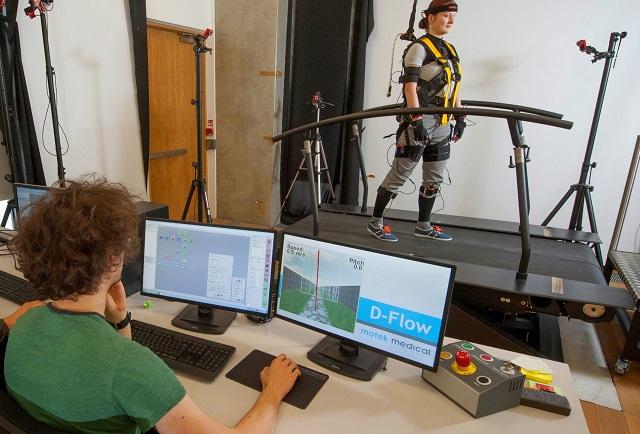
The Motek Medical M-Gait is a fully instrumented split-belt treadmill which is capable of simulating a wide variety of walking conditions. It features a six-axis force transducer on each belt for measuring the ground reaction forces on each foot independently. In addition, the pitch, sway and belt speed of the treadmill can be dynamically altered during operation, and an integrated projector can be used to create augmented reality environments. The M-Gait is a powerful tool for analysing human gait and balance, and in particular exoskeleton-assisted locomotion.
Specs:
-
Force sensing: 6 channels per plate (3D force and moment)
-
Pitch range of motion: -10° to 10°
-
Sway range of motion: -0.2m to 0.2m
-
Max speed: 5m/s
-
Sensing frequency: 600Hz
Vicon Motion Capture
The gait lab is equipped with a 10-camera passive motion capture system from Vicon. The capture volume is centred on the M-Gait treadmill (link), providing sufficient coverage to record gait data with minimal marker dropouts. A Vicon Lock+ box is used to synchronise the marker data signals with the analogue data from the M-Gait treadmill and other devices in the lab (e.g. EMG sensors).
Specs:
-
Cameras: 12
-
Sensing frequency: 100Hz
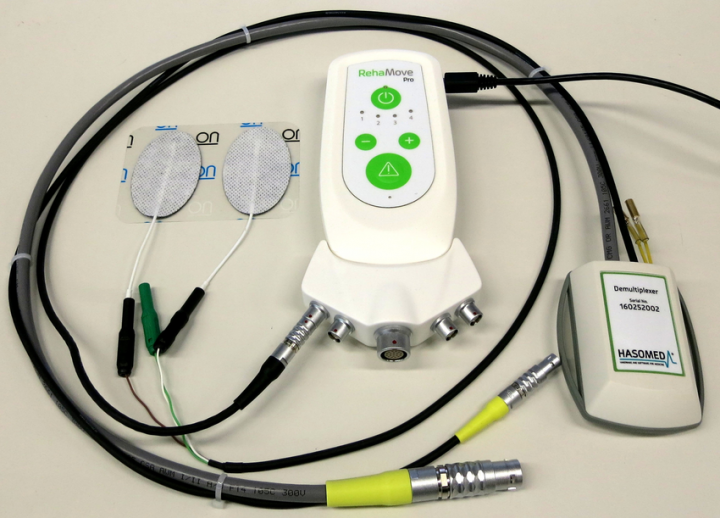
FES RehaMove-3
RehaMove 3 is a high performance stimulator used for artificial neuromuscular excitation. Neuromuscular electrical stimulation and functional electrical stimulation are used extensively in rehabilitation both as tools for therapeutic interventions and as assistive neuroprosthetic devices. RehaMove 3 devices offer 4 stimulation channels that can dynamically adjust all stimulation parameters through the ScienceMode protocol.
Specs: 4 stimulation channels, Frequency: 1 - 500 Hz, Pulse width: 10 μs - 4 ms (1μs steps), Amplitude: 0 - 130 mA (0.5 mA steps)
H3 Exoskeleton
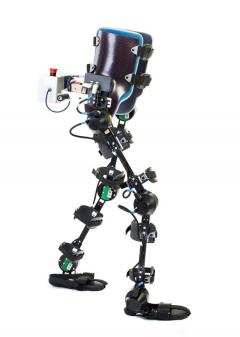
The H3 exoskeleton is a wearable robot designed for research, primarily in neurorehabilitation and robot control. It has six actuated degrees of freedom and can actively control the position and forces provided to the hips, the knees and the ankles. The height of the exoskeleton’s limbs and the hip width can be manually adjusted to fit the user. Two pressure sensors are located at each foot of the device to allow for different gait events such as heel strike and toe off to be detected.
Specs:
- Mass: 17kg (14.6kg without battery)
- Range of motion: Hip -30(ext.) to 105º (flex.)
- Range of motion: Knee -5º(ext.) to 105º (flex.)
- Range of motion: Ankle -30º (ext.) to 30º (flex.)
- Net torque: 35Nm
- Peak torque: 180Nm
- Max user’s weight: 100kg
IUVO Active Pelvis Orthosis
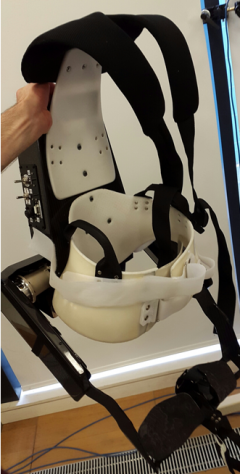
The Active Pelvis Orthosis (APO) is a powered exoskeleton designed for walking assistance and rehabilitation. It transmits forces to assist hip flexion and extension via carbon fibre lateral arms attached to the thighs of the wearer, which are themselves driven by series elastic actuators. The APO features encoders on each joint to allow for kinematic tracking and torsional springs to enable full torque sensing and control. The backpack segment of the device contains a battery which allows the device to be used untethered when required.
Specs:
-
Max torque: 35Nm.
-
Range of motion: -30° to 110°
-
Mass: 6.5kg
-
Control/sensing frequency: 100Hz
Advanced Sensing + Mapping Devices
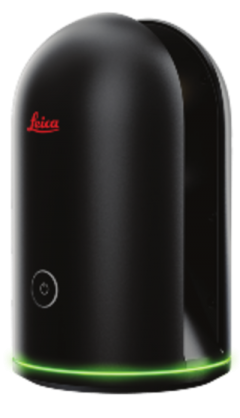
3DLaser Scanner BLK360
The Leica BLK360 is a small and portable, spherical imaging sensor. Its large spherical range (360° azimuth and 300° altitude) and fast scanning enable it to create accurate 3D colour point clouds of large environments. These 3D representations can be used in simulation or as a reference map for robot localisation. Additionally to depth and colour perception, the BLK360 has thermal imaging capabilities.
Technical Specification:
-
Range: 360° (horizontal) x 300° (vertical) x 0.6m - 60m (distance)
-
Accuracy: 6mm (at 10m) to 8mm (at 20m)
-
Speed: 360k points per second
Husky Mounted Velodyne
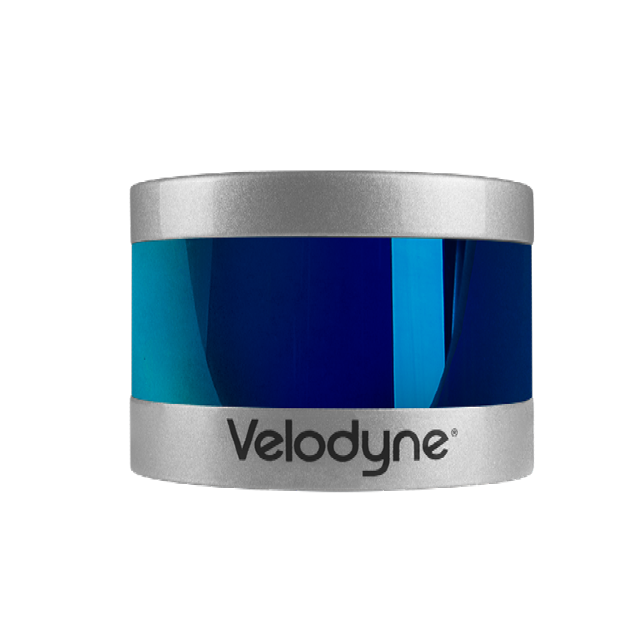
The Velodyne Puck (also known as VLP-16) is a very compact laser scanner with a full 360° azimuth field-of-view at 16 horizontal planes. This large scanning range allows to capture 3D point clouds on a mobile robot in real-time and enables localisation and perception. We have one of these installed on the Husky as well as the ANYmal Bedi.
Technical Specification:
-
Range: 360° (horizontal) x 30° (vertical) x 100m (distance)
-
Resolution: 0.1° - 0.4° (horizontal) x 2.0° (vertical)
-
Accuracy: 3m
-
Speed: 5 Hz - 20 Hz
BLUE: Variable Impedance Biped Prototype
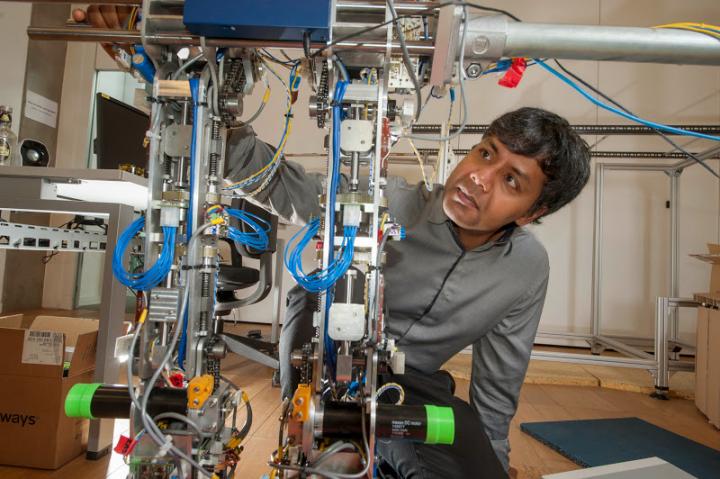
* Now archived*
Bipedal Locomotion at the University of Edinburgh (BLUE) is a planar bipedal robot developed completely in-house with joints capable of physically varying both their stiffness and damping independently – the first of its kind. Informed by human biophysics and locomotion studies, we designed an appropriate (heterogenous) impedance modulation mechanism that fits the necessary torque and stiffness range and rate requirements at each joint while ensuring the right form factor. In addition to hip, knee and ankle, the constructed robot is also equipped with a three part compliant foot modelled on human morphology. For more details, see: Alexander Enoch and Sethu Vijayakumar. Rapid Manufacture of Novel Variable Impedance Robots. ASME Journal of Mechanisms and Robotics (2015).
